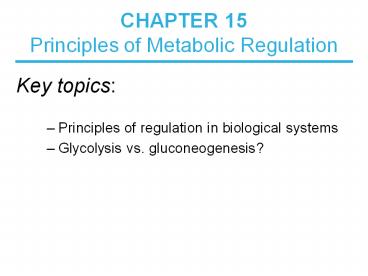CHAPTER 15 Principles of Metabolic Regulation - PowerPoint PPT Presentation
1 / 54
Title:
CHAPTER 15 Principles of Metabolic Regulation
Description:
Principles of Metabolic Regulation Key topics: Principles of regulation in biological systems Glycolysis vs. gluconeogenesis? * FIGURE 15-13 Regulation of hexokinase ... – PowerPoint PPT presentation
Number of Views:280
Avg rating:3.0/5.0
Title: CHAPTER 15 Principles of Metabolic Regulation
1
CHAPTER 15 Principles of Metabolic Regulation
Key topics
- Principles of regulation in biological systems
- Glycolysis vs. gluconeogenesis?
2
Metabolic Pathways
- The biochemical reactions in the living cell
the metabolism is organized into metabolic
pathways - The pathways have dedicated purposes
- Some are dedicated to extraction of energy
- Some are dedicated to storage of fuels
- Some are dedicated for synthesis of important
building blocks - Some are dedicated to elimination of waste
materials - The pathways can be represented as a map
- Follow the fate of metabolites and building
blocks - Identify enzymes that act on these metabolites
- Identify points and agents of regulation
- Identify sources of metabolic diseases
3
Map of Metabolic Pathways
4
(No Transcript)
5
Homeostasis
- Organisms maintain homeostasis by keeping the
concentrations of most metabolites at steady
state - In steady state, the rate of synthesis of a
metabolite equals the rate of breakdown of this
metabolite
6
Principles of Regulation
- The flow of metabolites through the pathways is
regulated to maintain homeostasis - Sometimes, the levels of required metabolites
must be altered very rapidly - Need to increase the capacity of glycolysis
during the action - Need to reduce the capacity of glycolysis after
the action - Need to increases the capacity of gluconeogenesis
after successful action
7
Feedback Inhibition
- In many cases, ultimate products of metabolic
pathways directly or indirectly inhibit their own
biosynthetic pathways - ATP inhibits the commitment step of glycolysis
8
(No Transcript)
9
Reactions Far From Equilibrium are Common Points
of Regulation
- Living systems thrive by keeping some metabolic
reactions far from equilibrium while the levels
of metabolites are in steady state
10
(No Transcript)
11
(No Transcript)
12
Rates of a Biochemical Reactions
- Rates of a biochemical reactions depend on many
factors - Concentration of reactants
- Activity of the catalyst
- Concentration of the enzyme
- Intrinsic activity of the enzyme
- Concentrations of effectors
- Allosteric regulators
- Competing substrates
- pH, ionic environment
- Temperature
13
(No Transcript)
14
(No Transcript)
15
Factors that Determine the Activity of Enzymes
16
(No Transcript)
17
Active Protein Molecules have a Finite Lifespan
- Different proteins in the same tissue have very
different half-lives - less than an hour to about a week for liver
enzymes - The stability correlates with the sequence at
N-terminus - Some proteins are as old as you are
- Crystallins in the eye lens
18
(No Transcript)
19
Phosphorylation of Enzymes Affects their Activity
- Protein phosphorylation is catalyzed by protein
kinases - Dephosphorylation is spontaneous, or catalyzed by
protein phosphatases - Typically, hydroxyl groups of Ser, Thr, or Tyr
are phosphorylated
20
(No Transcript)
21
Some Enzymes in the Pathway Limit the Flux of
Metabolites More than Others
- Hexokinase and phosphofructokinase are
appropriate targets for regulation of glycolytic
flux - Increased hexokinase activity enables activation
of glucose - Increased phosphofructokinase-1 activity enables
catabolism of activated glucose via glycolysis
22
(No Transcript)
23
Control of Glycogen Synthesis
- Insulin signaling pathway
- increases glucose import into muscle
- stimulates the activity of muscle hexokinase
- activates glycogen synthase
- Increased hexokinase activity enables activation
of glucose - Glycogen synthase makes glycogen for energy
storage
24
(No Transcript)
25
Regulation of Hexokinase IV by Sequestration
26
(No Transcript)
27
Rate of Reaction Depends on the Concentration of
Substrates
- The rate is more sensitive to concentration at
low concentrations - Frequency of substrate meeting the enzyme matters
- The rate becomes insensitive at high substrate
concentrations - The enzyme is nearly saturated with substrate
28
(No Transcript)
29
Isozymes may Show Different Kinetic Properties
- Isozymes are different enzymes that catalyze the
same reaction - They typically share similar sequences
- Their regulation is often different
30
(No Transcript)
31
Glycolysis vs. Gluconeogenesis
32
(No Transcript)
33
Regulation of Phosphofructokinase-1
- The conversion of fructose-6-phosphate to
fructose 1,6-bisphosphate is the commitment step
in glycolysis - ATP is a negative effector
- Do not spend glucose in glycolysis if there is
plenty of ATP
34
Phosphofructokinase-1 (PFK-1)
35
(No Transcript)
36
Regulation of Phosphofructokinase 1 and Fructose
1,6-Bisphosphatase
- Go glycolysis if AMP is high and ATP is low
- Go gluconeogenesis if AMP is low
37
(No Transcript)
38
Regulation by Fructose 2,6-Bisphosphate
- F26BP activates phosphofructokinase (glycolytic
enzyme) - F26BP inhibits fructose 1,6-bisphosphatase
(gluconeogenetic enzyme)
39
(No Transcript)
40
(No Transcript)
41
(No Transcript)
42
Regulation by Fructose 2,6-Bisphosphate
- Go glycolysis if F26BP is high
- Go gluconeogenesis if F26BP is low
43
(No Transcript)
44
Regulation of 2,6-Bisphosphate Levels
45
(No Transcript)
46
(No Transcript)
47
Molecular Origin of Enzyme Regulation
- Regulation of catalysis typically involves
- Binding of inhibitors, often to the active site
- Binding of regulatory protein subunits
48
(No Transcript)
49
Regulation of Pyruvate Kinase
- Signs of abundant energy supply allosterically
inhibit all pyruvate kinase isoforms - Signs of glucose depletion (glucagon) inactivate
liver pyruvate kinase via phosphorylation - Glucose from liver is exported to brain and other
vital organs
50
(No Transcript)
51
Two Alternative Fates for Pyruvate
- Pyruvate can be a source of new glucose
- Store energy as glycogen
- Generate NADPH via pentose phosphate pathway
- Pyruvate can be a source of acetyl-CoA
- Store energy as body fat
- Make ATP via citric acid cycle
- Acetyl-CoA stimulates glucose synthesis by
activating pyruvate carboxylase
52
(No Transcript)
53
Epinephrine and Glucagon Stimulate Breakdown of
Glycogen
54
(No Transcript)































